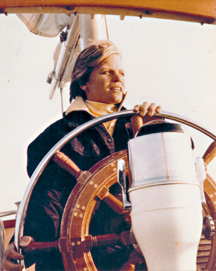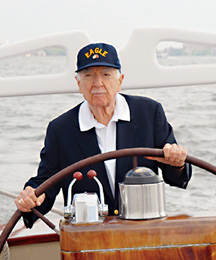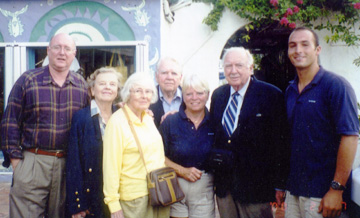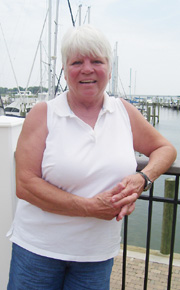
Volume XVII, Issue 41 # October 8 - October 14, 2009
|
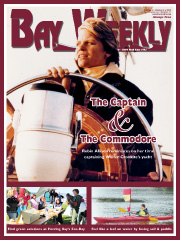 |
The Captain and The Commodore
Robin Allison reminisces over her time captaining
Walter Cronkite’s yacht
BY SANDRA OLIVETTI MARTIN
“Where do you go from Walter Cronkite?” mused Robin Allison, who for a year captained the penultimate sailboat the journalism legend christened Wyntje.
“John Travolta? He has a boat too. No, maybe not Travolta.”
Hooking Up with Mr. Cronkite
“If you’re a captain for important people, you’re usually away, on call, and you don’t have a personal life,” said the able-bodied, platinum-haired 65-year-old.
Which is why Allison had said no the first time Mr. Cronkite, as the captain calls him, “chatted” with her “about running a boat” for him. The year was 1977, and the place a locals’ bar in Bermuda, after Cronkite and Allison had separately sailed the Bermuda Ocean Race’s 125 miles down the Chesapeake and 628 miles offshore. Back then, Allison had younger children; she couldn’t follow wind and whim.
“But,” she recalls, “we stayed in touch, and a lot of years later, I learned over the coconut telegraph that he’d bought a boat I’d always loved.”
In the boating world, Allison explains, the coconut telegraph is omniscient. “Everybody on the water knows everything. Right now, someone’s saying, Do you know who’s sitting down and talking with Robin?”
The beloved boat was a Camper and Nicholson 60.
“I knew the boat as Trilogy,” Allison continues. “She was a beautifully rigged ketch with a dark-blue hull, teak decks and brass and shining chrome all over.
“She was a Bay boat. Mr. Cronkite bought her here in Annapolis, and she became the newest Wyntje.
“Three months later, I got a call and went up to interview in The Vineyard.”
He Was There
By 1998, Martha’s Vineyard had long been the Cronkites’ summer home, and the Commodore, as Cronkite’s captains called him, was 82 and long retired from television, where most of us got to know him. The prototypical anchorman didn’t coin the term, but he did define our expectations of that role by doing it early and doing it best.
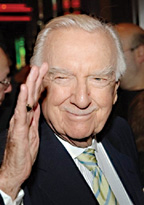
![]() Cronkite went to work for CBS back when television was all innovation. When he left print (and radio) journalism to work for WTOP-TV in 1950, he had no models for how a newsman should do television. He made the model.
Cronkite went to work for CBS back when television was all innovation. When he left print (and radio) journalism to work for WTOP-TV in 1950, he had no models for how a newsman should do television. He made the model.
As new as television was and as little of it as I had seen (we didn’t even own a television set yet), I had a gut feeling that television news delivery ought to be as informal as possible ... speaking to that single individual in front of his set in the intimacy of his own home, not to a gathering of thousands, he wrote in A Reporter’s Life.
For most of the events that defined the 20th century, Cronkite was there. As a United Press reporter, he helped tell the story of World War II in Europe, taking some of the risks of the soldiers, joining bombing raids over Germany and landing, hard, on enemy soil in a glider.
After the war, he covered the Nuremberg Trials of Nazi war criminals and reported from Moscow as the chill of the Cold War settled in.
Then, as a television newsman, he covered all the newsmakers of three decades, in everyday life and in the moments they made history: the first fully televised political convention in 1952 ... the riots of the 1968 Democratic Convention ... John F. Kennedy’s campaign, presidency, assassination and funeral ... the war in Vietnam and in America’s streets ... spaceflight and the moon landing ... Olympic games and massacres ... the Iran hostage crisis.
An avid, accurate reporter and an easy, vivid storyteller, Cronkite made his readers and listeners feel that they were there too.
|
|
Played Hard, Too
There has never been anything as exhilarating as driving at speed in competition, Cronkite wrote. Part of that exhilaration was attributable to the fear that gripped me before the race.
Deprecating as he was of himself and his prowess, he was a competitive racecar driver until his family responsibilities caused him to switch to sailing. Having grown up in America’s arid West, he’d never been on a sailboat before his fifth decade — though he’d made many ocean crossings in war and peace. But he quickly fell in love, and into his 80s he had a boat and sailed for pleasure, relaxation and the rush of competition:
For one thing, he wrote, it feeds the Walter Mitty in me ... never sail from harbor without either having a load of tea for Southampton or orders from the admiral to pursue that villain Long John Silver and his rapacious crew. I love the challenge of the open sea, the business of confronting Mother Nature and learning to live compatibly with her, avoiding if possible her excesses but always being prepared to weather them.
Allison confirms the breadth of her commodore’s taste for sailing: “He liked everything, from the feel of the water and independence of running his own ship to the fact that no two days are ever the same. Weather changes every day, so canvas changes every day.”
Our Wyntje
One thing that never changed was the name of Cronkite’s boat. It was always Wyntje, from a Westsail 42 in the early 1970s ... to a custom-built Sunward in the 1980s ... to the Camper and Nicholson 60 Allison captained in the 1990s ... to a Hinckley 60 in the new century.
“Wyntje was the name of his several- greats grandmother back in the late 1600s,” Allison explains. “‘It was the name, he said, of the first woman in the New Amsterdam colony to make a Cronkite man happy.’ As long as that was the story, it was okay with me and one of his favorite stories to tell. “
Our Wyntje could do about 71⁄2 knots when the wind was right and she was up and moving. Everything was electric or hydraulic. From bringing the sails in to flushing the toilets, it was all done by pushing a button. She had 85 horsepower in her engine.
“She was such a gorgeous boat and sailed so well. With the kids gone and nothing tying me down, I couldn’t not do it.
“So I signed on for two years, and with a mate and one crew, I did everything — and there was a fair amount of maintenance on all the systems — from varnishing to cooking to cleaning to entertaining to moving the boat.”
On the other hand, Allison says, “As captain, you were almost family.”
Sailing with Commodore Cronkite
Cronkite took to sailing with the same passion he pursued all of life.
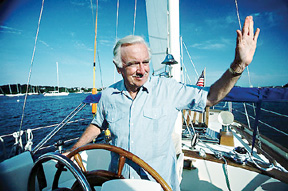 |
He almost hit the dock before tacking — but never did — just to see the look on people’s faces. |
![]() "He took time for his life,” Allison remembers. “He became a master of this passion, and it was a huge part of his life. He had the dedication and direction you’ve got to have to become a really good sailor. He was dedicated to making sure he was a Corinthian sailor, and he was.
"He took time for his life,” Allison remembers. “He became a master of this passion, and it was a huge part of his life. He had the dedication and direction you’ve got to have to become a really good sailor. He was dedicated to making sure he was a Corinthian sailor, and he was.
“He was one of the most skilled, thorough, careful, experienced seamen I have ever had the pleasure to sail with — someone you would go anywhere with.”
Capt. Allison’s voyages with Commodore Cronkite followed a yearly course: Maine, Nantucket in summer; Annapolis in spring and fall; Caribbean islands in winter. Because Cronkite was getting up in age, however, he did not make the longer passages, instead catching up with his boat in port.
Still, Allison remembers, “He liked to challenge himself a bit. On Martha’s Vineyard, he had the best time tacking toward the Edgartown Yacht Club so close you could touch the dock before he tacked. He got a great chuckle from the looks on the faces of the novices on board or on the dock. They were sure we were going to hit. We never did.”
There There was more to Walter Cronkite than adventure and tall tales. He and his wife Betsy were married for 65 years, raising three children who in turn gave the Cronkites four grandchildren.
“He was a real person who loved his grandchildren and cats and dogs,” Allison says. “His love of the boats he owned and the waters he sailed was exceeded only by his caring for family and friends and animals.”
Famous Passengers
Most common were the Rooneys.
Andy Rooney — who at 90 still does the three-decades-old CBS weekly 60 Minutes report A Few Minutes with Andy Rooney — and Walter Cronkite went back to World War II, when they were reporters together. They met again in early television and remained fast friends. Rooney gave Allison a celebrity story that mists her eyes on recall.
“On Virgin Gorda, we had an electrical problem, and as I was changing out the key switch early in the morning, Andy appeared and asked, ‘Can I help?’ ‘
Sir,’ I said, ‘coffee and fruit are ready, and I know you like to write early.’
“He said ‘I want to help.’ I handed him the screwdriver, and he helped disassemble and reassemble the pedestal.”
But nobody was better company than the Commodore himself.
“He was a great storyteller,” she says. “He liked to stay up late drinking Makers Mark. We’d be on anchor on a mooring, and talk to all hours of night. The conversations ran from the original astronauts — who remained close personal friends and called frequently — to Mamie and Ike Eisenhower, Castro, and the Kennedys, including Teddy. [The stories] were always fascinating, but he was always interested in your opinion — on everything from global warming to capitalism vs. socialism to who built the best boat.
“With Mr. Cronkite’s sense of humor and the opportunity to meet incredible people, it was a marvelous experience. He was a lovely man to sail with.”
|
|
 Change of Command
Change of Command
“I had been on board a bit more than a year when he fell in an airport and hurt himself,” Allison says of the end of her time with Cronkite a decade ago.
Regaining a life of her own brought Allison a husband, Captain Mark Steinlein. And she remains on the water, this time pushing sand and gravel barges through the Woodrow Wilson Bridge as first mate on his tugboat.
The couple built a house in Galesville on Steinlein’s family property in 2005. Eight months ago, their new home burned to the ground.
“I got out with the long T-shirt and Crocs I had on. He was wearing jeans; no shoes, no shirt.” Cat Dory and dog Schooner, a 121⁄2-pound papillon-Brittany spaniel cross, survived. Beyond their animals and clothes, everything was gone.
While the house is being rebuilt, the family of four lives on their boat, a Pearson 39.
No big deal. They were planning on going cruising, anyway.
